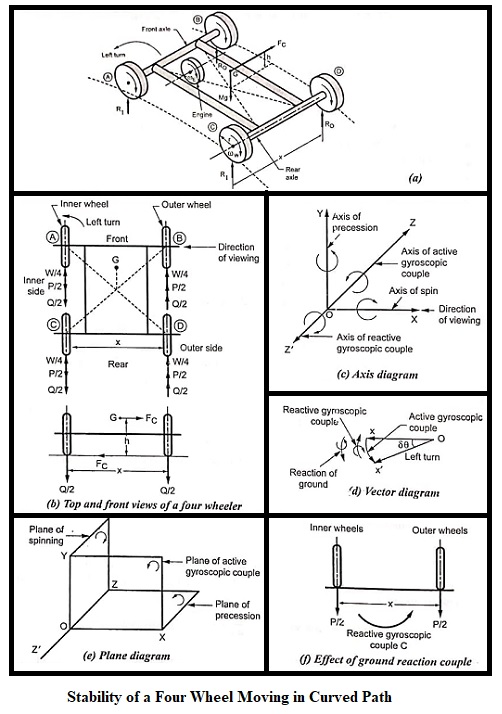Consider any four wheel automobile (say, car) having wheels A, B, C and D, taking a turn towards left on a curved path, as shown in Fig (a). The wheels A and C are inner wheels, whereas B and D are outer wheels. While the vehicle will move in a straight line there will not be any gyroscopic effect on it; but when it takes 2 turn (towards left or right), it will be subjected to gyroscopic couple.
In case of stability, it is essential that no wheel is supposed to be lifted off the ground while the vehicle takes a turn. The condition is fulfilled as long as the vertical reaction of the ground on any of the wheels is positive (or upwards). The centre of gravity (G) of the vehicle lies vertically above the road surface.
m = Mass of the vehicle in kg,
W = m. g = Weight of the vehicle in newtons,
rw = Radius of the wheels in metres,
R = Radius of curvature (R>rw) in metres,
𝑥 = Width of track in metres,
h = Distance of centre of gravity above the road surface in metres,
Iw = Mass moment of inertia of each wheels in kg=m²,
ωw = Angular velocity of the wheels or velocity of spin in road/s,
IE = Mass moment of inertia of the rotating parts of the engine in kg-m²,
ωE = Angular velocity of the rotating parts of the engine in rad/s,
G = Gear ratio = ωE/ωw ,and
v = Linear velocity of the vehicle in m/s = rw/ωw
In order to determine the reaction of the ground on the vehicle, when the vehicle taking a turn, the following three loads acting on the vehicle should be considered(Fig (a)):
- Weight of the vehicle (W),
- Reactive gyroscopic couple (C), and
- Centrifugal force (FC)
Reaction due to weight of the vehicle
The weight of the vehicle (W) is equally distributed over four wheels which will act downwards. The equal and opposite reaction will be offered by the road surface to the wheels in the upward direction.
Weight on each wheel = W/4 = m.g /4 (downwards)
∴ Reaction of ground on each wheel = W/4 = m.g/4 (upwards)

Reaction due to gyroscopic couple (Effect of the gyroscopic couple)
Due to the rotating wheels and the rotating parts of engine of the vehicle, the vehicle will be subjected to gyroscopic couple while taking a turn. Since four wheels and engine may rotate with different speed and in different directions, therefore the four wheels and engine should be considered as two different set of rotors.
Correspondingly, they will produce different reactive gyroscopic couple. So we have to find the gyroscopic couple due to four wheels and due to rotating parts of the engine separately. We know that the angular velocity of precession,
![]()
Reactive gyroscopic couple due to four wheels is given by
![]()
Gyroscopic couple due to the rotating parts of the engine is given by
CE = IE . ωE . ωP = IE . G . ωW . ωP [∵ G = ωE /ωW]
Net reactive gyroscopic couple acting on the vehicle is given by
∴ 
In equation, positive sign is used when the engine parts rotate in the same direction as the wheels and the negative sign when they rotate in the opposite direction.
Fig shows the line sketch of the vehicle taking left turn on the curved path. Fig (d) shows the vector diagram representing the direction of reactive gyroscopic couple. Fig (c) and (e) depict the axis and plane diagrams and Fig (f) shows the effect of ground reaction couple.
This gyroscopic couple produces reaction on the road surface. This reaction is positive on the outer wheels and negative on the inner wheels. Let the magnitude of this reaction at the two outer and inner wheels be ‘P’ newtons.
Then, P . 𝑥 = C or P = C/𝑥
∴ Vertical reaction of ground on each outer wheel,
P/2 = C/2𝑥 (upward)
and vertical reaction of ground on each inner wheel,
P/2 = C/2𝑥 (downwards)
Reaction due to centrifugal effect (effect of the centrifugal couple)
As the vehicle moves on a curved path, a centrifugal force also acts on the vehicle in the outward direction at the centre gravity of the vehicle.
We know that the centrifugal force acting through the centre of gravity of the vehicle,
![]()
This centrifugal force produces a couple which will tend to overturn the wheels, i.e., the couple due to centrifugal force tends to lift the inner wheels and press the outer wheels.
The overturning couple is given by
![]()
This overturning couple is balanced by vertical reactions, which are vertically upwards on the outer wheels and vertically downwards on the inner wheels. Let the magnitude of this reaction at the two outer or inner wheels be ‘Q’.
Then, Q . 𝑥 = CO
or ![]()
∴ Vertical reaction of ground on each outer wheel,
![]()
and vertical reaction of ground on each inner wheel,
![]()
Total Reaction
Let RO = Vertical reaction on each outer wheel in newtons, and
R1 = Vertical reaction on each inner wheel in newtons.
∴ Total vertical reaction at each of the outer wheel,
![]()
and total vertical reaction at each of the inner wheel,
![]()
It can be inferred that when the vehicle will be running at high speeds, P/2 and Q/2 will increase and this can reduce R1 to zero or even negative. Naturally, the inner wheels will be free to leave the road, thus tending to overturn the vehicle. To ensure firm contact at the inner wheels with the road, W/4 should be more than or at least equal to the sum of P/2 and Q/2.
In other words, for stability of the vehicle ![]()
| Read More Topics |
| Precessional angular motion |
| Gyroscopic effect |
| Wilson hartnell governor |





